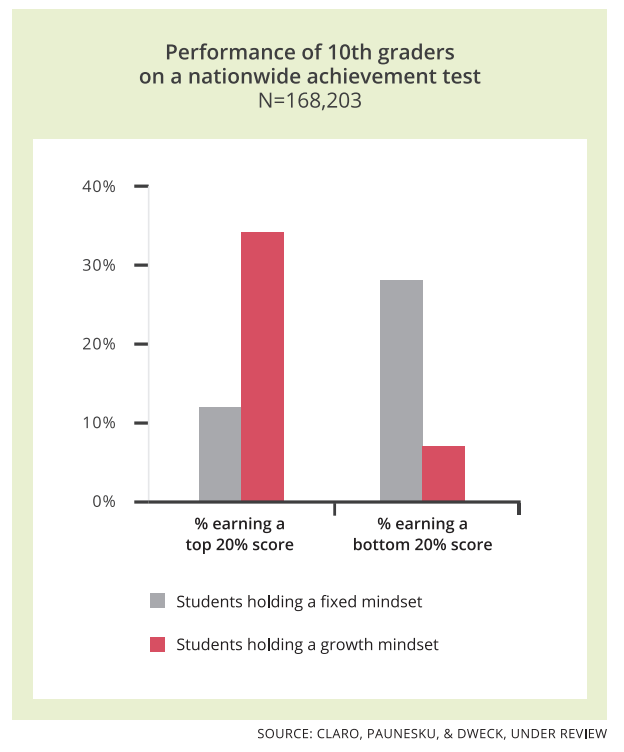
A growth mindset is when we believe our intelligence and abilities can be improved with effort and the right strategies. It also implies that we don’t perceive failure as evidence of being unintelligent, but as a springboard for the growth and development of our abilities. As a parent, if you’re here trying to figure out ways to inculcate a growth mindset in your child, congratulations! Putting developing a ‘growth mindset’ in your goals as a parent is the first winning step. The journey only gets a tad bit easier from here, we promise.
The Role of a Parent in Developing a Growth Mindset in their Child
It is true that students with a growth mindset do better at school, secure higher grades, and have more accomplishments in general. Here is a sneak peek at research-based evidence:
Students holding a growth mindset were far more likely to score in the top 20% on a nationwide achievement test. (source: studentexperiencenetwork.org)

However, a growth mindset is not and should not be considered limited to schoolwork or excellence in a sport or an art. A growth mindset is an overall attitude that applies to all walks of life and is not only about excellence at school! This is why your role as a parent is all the more important. While the school environment, teachers, and coaches do play a role, your child’s biggest influence in having a growth mindset is going to be YOU. At home is where a child learns to reflect on their mistakes, plan for their overall life (and not just homework), etc.
With this in perspective, let’s dive straight into the HOWs of developing a growth mindset in your child:
1. Help them set SMART goals
Teaching your children to set goals and devise an action plan to achieve them is the first step. When your children know that they can achieve a goal with persistence and hard work, they learn to deal with failure differently. However, setting goals is not enough, teaching your child how to set SMART goals is the real key. Vague goals often lead to quick dismissal in the face of failure or hardships hence, SMART goals are a key to developing a growth mindset.
SMART goals are goals that are:
- Specific
- Measurable
- Achievable
- Relevant and,
- Time-bound
An example of a SMART goal is: “I want to improve my GPA so I can apply for a student exchange program next year which has minimum GPA criteria. I will earn a B or better on my Math and English midterm exam.”
Also Read: A Parent’s Guide to Raising Resilient Kids
2. Identify limiting beliefs and clear all negative blocks
Getting rid of limiting beliefs is a primary step in developing a growth mindset. Pay attention to your child’s casual statements about academics, sports, art, and other attributes like friendship, love, courage, etc. This is how you can identify limiting beliefs that your child may be holding on to. Limiting beliefs can deter them from making good choices, taking on new opportunities, or reaching their full potential.
Statements like these are examples of holding on to limiting beliefs:
- “I don’t ask questions or else I’ll look stupid.”
- “No one likes me from the music group.”
- “I can’t tackle math!”
By using positive statements and motivation you can help your child overcome these limiting beliefs over time. Replace one negative sentence with a positive outlook and build your way up, clearing all possible limiting beliefs.
3. Build a constructive feedback loop
In the face of failure, give your child constructive feedback and improvement action steps instead of scolding them. For example, instead of asking a question like, “Why are your math grades so poor yet again?” flip the switch and do this:
- Sit down with your child and go through the question paper
- Ask them to point out questions where they lost marks due to a silly mistake and due to a conceptual difficulty
- Ask them to devise a combat plan themselves
- Give them feedback on their ‘approach’ towards analyzing their mistakes and not on their mistakes alone. For example, “I see you are attributing the low score to only algebra, don’t you think there is scope for improvement in geometry as well?”
4. Change their perception towards mistakes and failure
Celebrating failure is a movie-cliche nowadays, but it’s nonetheless effective! Celebrate not only your child’s successes but also failures. Take them for a walk, dig into their favorite ice cream or watch a TV show with them to unwind. Let them talk openly about failure, mistakes, and the lessons.

Appreciate whenever your child presents a lesson they’ve learned. Teach them that failure is not a bad thing, it is only a learning opportunity and hence, they shouldn’t be scared of it. Affirm often, with positive talk that that recognizing the lesson hidden in the failure is the path to bigger success.
Also Read: A Parent’s Guide to Empower Struggling Middle School Readers
5. Explore growth mindset activities
There are a bunch of growth mindset activities that you can explore for your child. The best part? A lot of them are available online for free! We love the downloadable activities (quizzes, self-reflection questionnaires, etc.) available here.
We particularly recommend using this growth action plan template. This will help your child give structure and direction to self-reflection. It, in turn, goes a long way towards developing a growth mindset.
6. Foster grit and resilience using home activities
At-home activities are a great way to foster grit and a growth mindset. Allow your child to help you with daily chores. Encourage them to reach for perfection even while vacuuming or mopping the floor. Teach them to reach for the most difficult corners and come up with ingenious solutions. For example, while cooking, ask your child to come up with a replacement ingredient with some research on the internet instead of giving up on a recipe.
7. Introduce them to mindfulness
Mindfulness is nothing but the ability to be fully present and aware of where we are and what we are doing. This helps build focus and resilience – both the attributes of having a growth mindset. Being able to focus on the present without burdening it with thoughts from the past or fears for the future is a direct result of practicing mindfulness.
We love this mindfulness meditation for kids, it’s a great starting point for young kids!
8. Teach them self-advocacy
Self-advocacy is knowing what to choose based on our estimation of all possible outcomes. It’s the ability to plan and take action whenever needed while using problem-solving skills. A growth mindset is all about believing that everything is possible with passion and hard work and being 100% accountable for our actions.
Self-advocacy can be taught to children by:
- Encouraging them to speak up for themselves
- Have and share their opinions even in a large group
- Nurturing their independence and respecting their choices
- Giving them ownership of their problems and feelings
- Encouraging them to back their opinions with research and reading to give them more confidence
Also read: How to encourage your shy child to speak up in public
9. Use praise effectively
One of the most intuitive things while fostering a growth mindset in your child is to praise them. But hey, by the word ‘praise’ we don’t mean a dollop of sugar-coated words every now and then! Use praise to nurture your child’s confidence and self-worth. Use simple phrases like, “good job”, “oh you finally got that, so good!”, etc. to simply acknowledge their effort and outcomes.
Remember to praise them even when they fail, that’s when praise has the most impact. Next time replace all the ‘oh no!” sentences with “oh, you can fix this. Let’s try!”
10. Lead by example
Lastly, lead by example. Children will follow your mannerisms and approach towards life more than anything else. Hence, make sure to deploy a growth mindset yourself first. For example, next time when the car breaks down, replace your shriek of frustration or disappointment with, “okay, let’s try to fix this ourselves while help arrives.” Display an attitude of resilience and not giving up while trying new tasks and handling daily chores, alike!

How can a life coach help my child build a growth mindset?
Now, while as a parent you can do a lot of things every day to develop a growth mindset in your child, getting an extra nudge is also a good idea. After a point in time, your child may become disinterested in continuing at-home activities or can become dissuaded by external pressures. This is where the role of a growth mindset coach comes in.
A life coach can not only help clear fixated beliefs of your child but can open a new door of learning for them. Speaking to someone who’s unbiased and invested in them, makes children respond faster and more effectively.
Also Read: Understanding Why Kids Face Reading Struggle
Help is around the corner!
At Talentnook, we bring together thousands of students and professional, highly experienced tutors from the very neighborhood. These are the tutors your child might need and you may otherwise never know about them! Visit Talentnook.com, explore tutor profiles, request free demo sessions, explore study pods and specialized programs for upskilling your child. From math to the piano to essay writing and growth mindset, we’ve got you covered!
Happy learning!